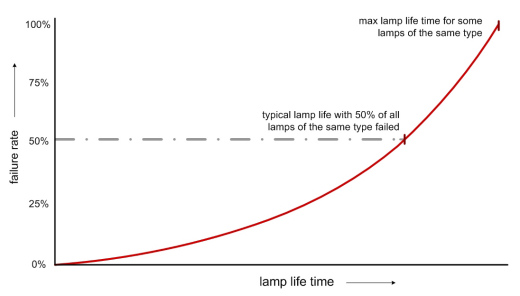At InfoComm 2015, I asked a number of solid-state light source projector makers to explain what their lifetime measurement meant. The results were widely inconsistent, which means you had better ask the definition of lifetime as there is no way today to do an apples-to-apples comparison of this spec.

Some are defining the 20,000 or 30,000-hour lifetime as the time to 50% of initial brightness. This sounds like it is consistent with the way lamps are rated, but not necessarily.
According to Philips Lighting, if the lifetime of a UHP lamp is specified as 5,000 hours, for example, that means that 50% of the lamps will have 50% of their original brightness at 5,000 hours. It is commonly assumed that the 5,000 hour lifetime means only the 50% brightness part. But there is a distribution around this point, which means that some users will be at 60% of brightness at 5,000 hours and some at 40% of brightness.


The new ColorSpark High Lumen Density (HLD) technology from Philips Lighting is specified a bit differently. The spec for this light source, which includes a green color conversion rod, plus red and blue LEDs, is 20,000 hours. This means that at 20,000 hours, 50% of the light sources will be at 70% of their original luminance.
Many of the laser phosphor projector makers are quoting 20,000 hours as well, but I have heard specs that are to 80%, 70% and 50% of initial brightness. Do they mean that 50% of the light sources will be at these luminance levels at the lifetime mark? They don’t say or don’t know. Does this mean the light output of the blue pumping lasers or the light output of the projector? In other words, is the phosphor conversion process stable over this time period or is it the degradation of the laser and the phosphor?
But the lifetime also depends upon the mode the projector is running in. This lifetime spec may refer to operation in the standard “bright” mode or in the “eco” lower lumen mode. You’d better ask for clarification on this as there can be a big difference.
The temperature control of the laser, LEDs and the phosphor are critical for lifetime – the higher the temperature the shorter the lifetime. Looking into the projector thermal management of these elements may seem like digging too deep into the guts of the projector, but if you want to really understand the lifetime specification, this is a necessity.
Others say that when you get to 30K or 20K hours of projector use, it is now at end of life, without commenting on what the light output level is at this point.
There are even some laser-phosphor projectors that are rated for a constant light output for the rated lifetime. That means you have to over spec the solid-state light sources for the projector so you can under-drive them initially and increase drive current over time to maintain that constant brightness.
Is there a solution? I am not aware of a good regulatory body that can set a standard that projector makers would agree to. Maybe ICDM (the International Committee on Display Metrology) has a recommended lifetime measurement for laser phosphor projectors. If they do, please write to me or post a comment below.
Otherwise, it’s “caveat emptor”, or “buyer beware” when it comes to lifetime for a projector with a solid state light source, unless we can build some consensus on how to specify projector lifetime. Please add your comments to this article to help move the discussion along. – Chris Chinnock

